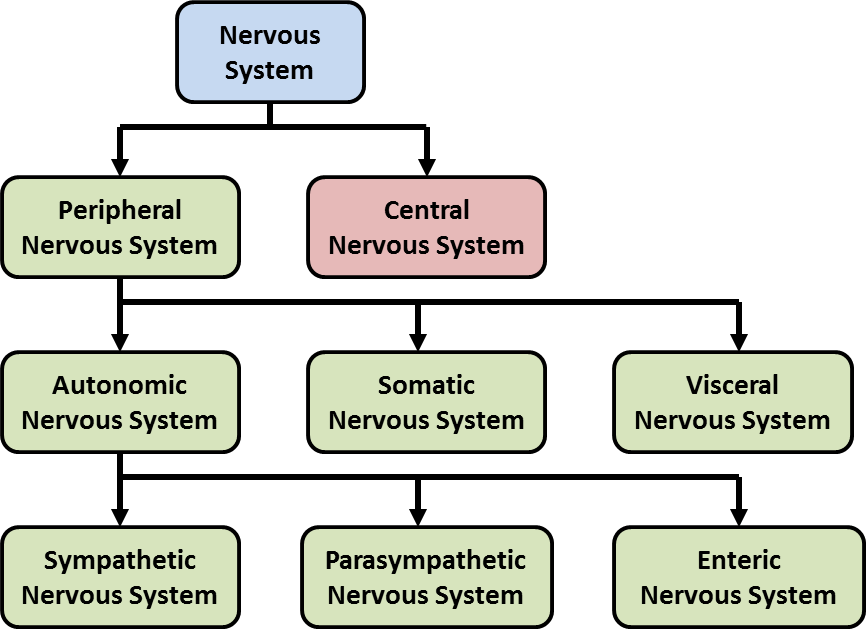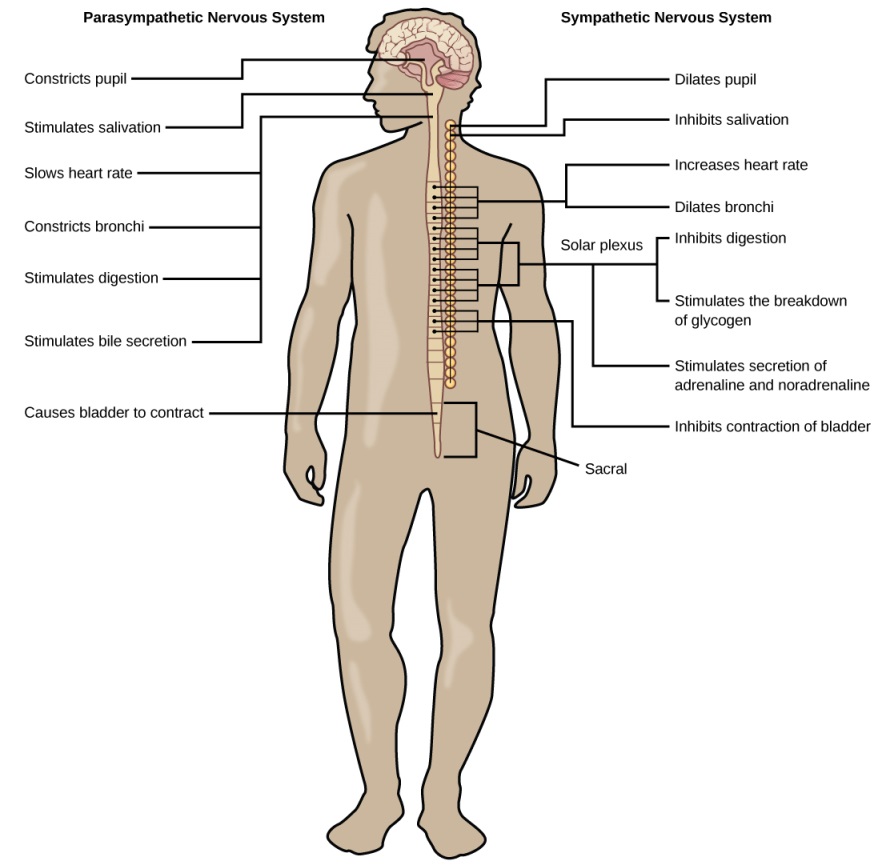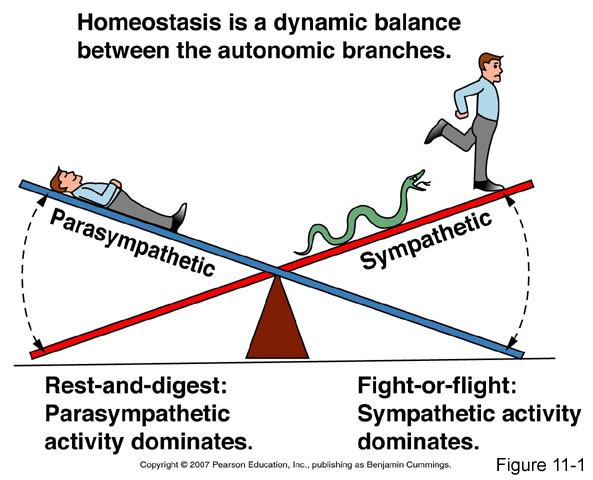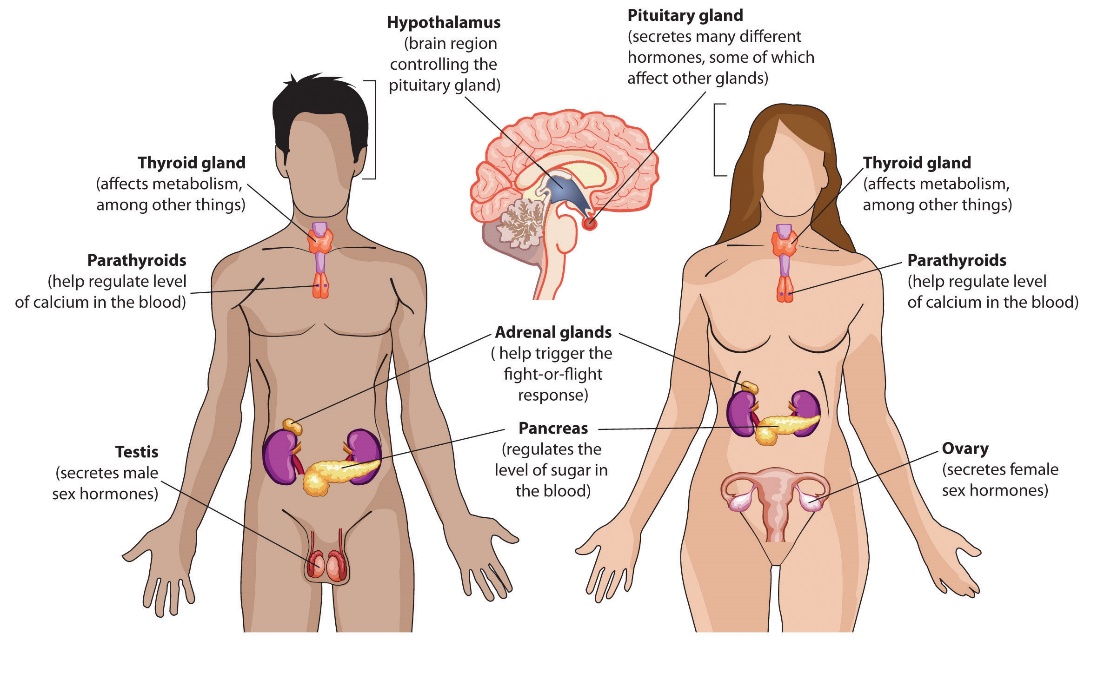Divisions of the Nervous System
Introduction
Our bodies consist of several systems in order to accomplish various goals: breathing, heart beating, consuming, reproducing, moving, and more. Indeed, we have 10+ body systems, which all work together to sustain life.
Briefly, we have the following body systems:
- Respiratory
- Digestive / Excretory
- Cardiovascular / Circulatory
- Renal / Urinary
- Endocrine
- Musculoskeletal
- Integumentary / Exocrine (skin)
- Lymphatic / Immune
- Reproductive
- Nervous System
The nervous system is a system of nerves– it is a network of special cells that send and receive messages. These cells are special because they send and receive messages in a different way than the cells of the body.
The nervous system has three basic functions:
1. To receive input through senses (sight, sound, taste, smell, touch)
2. To process information through cognition (attention, perception, learning)
3. To respond to information through action (movement)
Importantly, the nervous system, as a network of cells, can be categorized into various divisions and subdivisions.
The major ways that the nervous system is divided is based on three factors: location, function, and purpose.
Divisions of the Nervous System
How is the Nervous System Divided?
The initial way to divide the nervous system is based on location.
The main divisions of the nervous system are the central nervous system (CNS), which consists of the brain and spinal cord. The spinal cord is a critical set of nerves that links the central nervous system to the peripheral nervous system (PNS), which is the network of nerves located throughout the body itself.
The subsequent way to divide the peripheral nervous system is based on function.
The two subdivisions of the peripheral nervous system are the somatic nervous system (SNS) and the autonomic nervous system (ANS). The somatic nervous system consists of the set of nerves that are involved in voluntary, conscious movement – meaning that they innervate our skeletal muscles, such as in our arms and legs. On the other hand, the autonomic nervous system (think “auto” for “automatic”) consists of the set of nerves that are involved in involuntary, subconscious movement – meaning that they innervate our visceral organs, such as our heart, liver, kidney, lungs, etc.

“Components of the Nervous System.” by Jenna Fair. Retrieved from: https://commons.wikimedia.org/wiki/File:Components_of_the_Nervous_System.png. Licensed under: CC-BY-SA 3.0.
Finally, we can divide the autonomic nervous system based on purpose.
The two subdivisions of the autonomic nervous system are the sympathetic nervous system and the parasympathetic nervous system. The sympathetic system is responsible for our fight-or-flight mechanism (think “s” for “scared”).
If you are wondering why the sympathetic system is active when we are afraid, which is counter-intuitive to its name, you have Claudius Galen, a Greek physician, to thank. He proposed that “animal spirits” flowed throughout the body, creating “sympathy” (think “harmony”). And so, he named this system the sympathetic system.
Balancing the sympathetic nervous system is the parasympathetic nervous system, which is responsible for our “rest-and-digest” mechanism (think “p” for “peaceful”). The prefix “para” means beside/alongside. Indeed, the parasympathetic system operates alongside the sympathetic system.

“Biology” by CNX OpenStax. Retrieved from https://cnx.org/contents/VqjFMmZP@3/The-Peripheral-Nervous-System. Licensed under CC-BY-4.0.
How Does this Categorization Subserve Behavior?
An important underlying axiom to the sciences is that structure subserves function, meaning that the way something looks likely speaks to the way something works. When you see a giraffe, it is not surprising to hear that it functions differently than a hippopotamus. The same is true in biology.
The observation that the nervous system is divided in such a way gives rise to considering what that structure might mean for function. Indeed, a major goal of our bodily systems is to maintain equilibrium, or a balanced state. The process by which our bodies achieve this balance is called homeostasis.
Homeostatic regulatory mechanisms can be observed at the involuntary, molecular level – hormones coursing through our blood – and at the voluntary, skeletal level – actions and movements that we take.
Our autonomic system produces these molecular signals to suggest to our body that we are imbalanced, so that we can take actions to compensate. For example, you feel hungry throughout the day due to specific hormones that signal an imbalance. You notice this feeling and take steps accordingly.
These two systems operate alongside each other – autonomic control moves between the two—they cooperate in order to produce complex, finely-tuned processes. Occasionally, as in the case of significant stress, the balance will be heavily biased towards the sympathetic – fight-or-flight—branch.

Pearson Education, Inc., 2007. Retrieved from https://content.openclass.com/eps/pearson-reader/api/item/ab914c98-1923-486b-bdb4-b9187be18b9e/1/file/silverthornHP7-071415-MJ-BO/OPS/s9ml/chapter11/filep7000495934000000000000000004122.xhtml. Licensed under CC-BY-SA.
The Body’s Chemicals Help Control Behavior: The Endocrine System
The nervous system is designed to protect us from danger through its interpretation of and reactions to stimuli. But a primary function of the sympathetic and parasympathetic nervous systems is to interact with the endocrine system to elicit chemicals that provide another system for influencing our feelings and behaviors.
A gland in the endocrine system is made up of groups of cells that function to secrete hormones. A hormone is a chemical that moves throughout the body to help regulate emotions and behaviors. When the hormones released by one gland arrive at receptor tissues or other glands, these receiving receptors may trigger the release of other hormones, resulting in a series of complex chemical chain reactions. The endocrine system works together with the nervous system to influence many aspects of human behavior, including growth, reproduction, and metabolism. And the endocrine system plays a vital role in emotions. Because the glands in men and women differ, hormones also help explain some of the observed behavioral differences between men and women.

Stangor, C. (2017). Introduction to psychology. Boston, MA: Flatworld.
The pituitary gland, a small pea-sized gland located near the center of the brain, is responsible for controlling the body’s growth, but it also has many other influences that make it of primary importance to regulating behavior. The pituitary secretes hormones that influence our responses to pain as well as hormones that signal the ovaries and testes to make sex hormones. The pituitary gland also controls ovulation and the menstrual cycle in women. Because the pituitary has such an important influence on other glands, it is sometimes known as the “master gland.
Other glands in the endocrine system include the pancreas, which secretes hormones designed to keep the body supplied with fuel to produce and maintain stores of energy; the pineal gland, located in the middle of the brain, which secretes melatonin, a hormone that helps regulate the wake-sleep cycle; and the thyroid and parathyroid glands, which are responsible for determining how quickly the body uses energy and hormones, and controlling the amount of calcium in the blood and bone.
The body has two triangular adrenal glands, one atop each kidney. The adrenal glands produce hormones that regulate salt and water balance in the body, and they are involved in metabolism, the immune system, and sexual development and function. The most important function of the adrenal glands is to secrete the hormones epinephrine (also known as adrenaline) and norepinephrine (also known as noradrenaline) when we are excited, threatened, or stressed. Epinephrine and norepinephrine stimulate the sympathetic division of the ANS, causing increased heart and lung activity, dilation of the pupils, and increases in blood sugar, which give the body a surge of energy to respond to a threat. The activity and role of the adrenal glands in response to stress provides an excellent example of the close relationship and interdependency of the nervous and endocrine systems. A quick-acting nervous system is essential for immediate activation of the adrenal glands, while the endocrine system mobilizes the body for action.
The male sex glands, known as the testes, secrete a number of hormones, the most important of which is testosterone, the male sex hormone. Testosterone regulates body changes associated with sexual development, including enlargement of the penis, deepening of the voice, growth of facial and pubic hair, and the increase in muscle growth and strength. The ovaries, the female sex glands, are located in the pelvis. They produce eggs and secrete the female hormones estrogen and progesterone. Estrogen is involved in the development of female sexual features, including breast growth, the accumulation of body fat around the hips and thighs, and the growth spurt that occurs during puberty. Both estrogen and progesterone are also involved in pregnancy and the regulation of the menstrual cycle.
Recent research has pinpointed some of the important roles of the sex hormones in social behavior. Dabbs, Hargrove, and Heusel (1996) measured the testosterone levels of 240 men who were members of 12 fraternities at two universities. They also obtained descriptions of the fraternities from university officials, fraternity officers, yearbook and chapter house photographs, and researcher field notes. The researchers correlated the testosterone levels and the descriptions of each fraternity. They found that the fraternities with the highest average testosterone levels were also more wild and unruly, and one of these fraternities was known across campus for the crudeness of its behavior. On the other hand, the fraternities with the lowest average testosterone levels were better behaved, friendly and pleasant, academically successful, and socially responsible. Banks and Dabbs (1996) found that juvenile delinquents and prisoners who had high levels of testosterone also acted more violently, and Tremblay et al. (1998) found that testosterone was related to toughness and leadership behaviors in adolescent boys. Although testosterone levels are higher in men than in women, the relationship between testosterone and aggression is not limited to males. Studies have also shown a positive relationship between testosterone and aggression and related behaviors (such as competitiveness) in women (Cashdan, 2003).
It must be kept in mind that the observed relationships between testosterone levels and aggressive behavior that have been found in these studies do not prove that testosterone causes aggression—the relationships are only correlational. In fact, there is evidence that the relationship between violence and testosterone also goes in the other direction: Playing an aggressive game, such as tennis or even chess, increases the testosterone levels of the winners and decreases the testosterone levels of losers (Gladue, Boechler, & McCaul, 1989; Mazur, Booth, & Dabbs, 1992), and perhaps this is why excited soccer fans sometimes riot when their team wins.
Recent research has also begun to document the role that female sex hormones may play in reactions to others. A study about hormonal influences on social-cognitive functioning (Macrae, Alnwick, Milne, & Schloerscheidt, 2002) found that women were more easily able to perceive and categorize male faces during the more fertile phases of their menstrual cycles. Although researchers did not directly measure the presence of hormones, it is likely that phase-specific hormonal differences influenced the women’s perceptions.
Banks, T., & Dabbs, J. M., Jr. (1996). Salivary testosterone and cortisol in delinquent and violent urban subculture. Journal of Social Psychology, 136(1), 49–56.
Cashdan, E. (2003). Hormones and competitive aggression in women. Aggressive Behavior, 29(2), 107–115.
Dabbs, J. M., Jr., Hargrove, M. F., & Heusel, C. (1996). Testosterone differences among college fraternities: Well-behaved vs. rambunctious. Personality and Individual Differences, 20(2), 157–161.
Gladue, B. A., Boechler, M., & McCaul, K. D. (1989). Hormonal response to competition in human males. Aggressive Behavior, 15(6), 409–422; Mazur, A., Booth, A., & Dabbs, J. M. (1992). Testosterone and chess competition. Social Psychology Quarterly, 55(1), 70–77.
Macrae, C. N., Alnwick, K. A., Milne, A. B., & Schloerscheidt, A. M. (2002). Person perception across the menstrual cycle: Hormonal influences on social-cognitive functioning. Psychological Science, 13(6), 532–536.↑
Stangor, C. (2017). Introduction to psychology. Boston, MA: Flatworld.
Tremblay, R. E., Schaal, B., Boulerice, B., Arseneault, L., Soussignan, R. G., Paquette, D., & Laurent, D. (1998). Testosterone, physical aggression, dominance, and physical development in early adolescence. International Journal of Behavioral Development, 22(4), 753–777.
Divisions of the Nervous System-Video
Neuroscientifically Challenged. (2014, August 8). 2-minute neuroscience: Divisions of the nervous system. [Video File]. Retrieved from: https://www.youtube.com/watch?v=q3OITaAZLNc. Standard YouTube License.
Interactive Biology. (2011, August 16). The divisions of the nervous system. [Video File]. Retrieved from https://www.youtube.com/watch?v=dOYOdJG0E0s. Standard YouTube License.
CrashCourse. (2015, June 22). Endocrine system part 1: Glands and hormones. Crash course A&P #23. [Video File]. Retrieved from https://www.youtube.com/watch?v=eWHH9je2zG4. Standard YouTube License.
Summary
Our bodies have multiple systems, corresponding to the multitude of complex behaviors that keep us alive.
The ten body systems are as follows:
- Respiratory
- Digestive / Excretory
- Cardiovascular / Circulatory
- Renal / Urinary
- Endocrine
- Musculoskeletal
- Integumentary / Exocrine (skin)
- Lymphatic / Immune
- Reproductive
- Nervous System
This 10th system, the nervous system, is of principal importance in our discussion of how the body produces behavior – it is through the brain.
The nervous system is a network of cells that send and receive messages. It is not surprising, then, that it’s most basic functions are to receive input, process information, and respond accordingly.
Based on three factors – location, function, and purpose – we can categorize the nervous system into multiple subdivisions. The central and peripheral nervous systems are determined by location. From there, the peripheral system is subdivided, based on function, into the somatic (voluntary) and autonomic (involuntary) systems. Finally, based on purpose, the autonomic system branches into the sympathetic (fight-or-flight) and parasympathetic (rest-and-digest) systems.
Glands in the endocrine system include the pituitary gland, the pancreas, the adrenal glands, and the male and female sex glands. The male sex hormone testosterone and the female sex hormones estrogen and progesterone play important roles in behavior and contribute to gender differences.
These subdivisions complement each other, providing different pieces of the same puzzle to accomplish many goals. In particular, our body works to accomplish homeostasis, the process of maintaining equilibrium.
Assessment Questions: “Anatomy and Physiology: Chapter 12, Section 1: Basic Structure and Function of the Nervous System.” by OpenStax. Retrieved from https://opentextbc.ca/anatomyandphysiology/chapter/12-1-basic-structure-and-function-of-the-nervous-system/. Licensed under CC BY.
Stangor, C. (2017). Introduction to psychology. Boston, MA: Flatworld.